Giancarlo Stanton among four struggling MLB Players who can turn it around and two who won’t

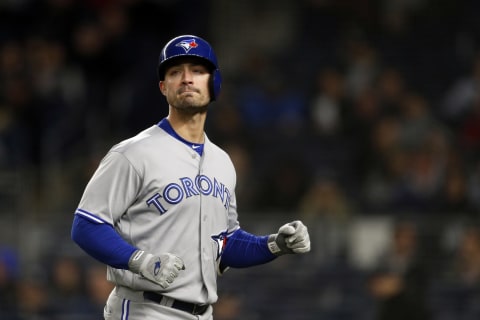
With the first month in the books, it’s worth looking at some struggling players, including Giancarlo Stanton, to see which ones we can expect to bounce back and which ones might be in for a rough season.
April was a fascinating month of baseball. It was loaded with surprises, like the Boston Red Sox winning 21 games and the New York Mets going 17-9. The Los Angeles Dodgers are looking bad, and the Arizona Diamondbacks look like the most complete team in the majors.
But perhaps most surprising of all is the list of players stumbling out of the gate, including the likes of Giancarlo Stanton. Can these struggling MLB players figure it out?
Will Giancarlo Stanton return to his MVP ways?
(Stats current as of the end of April.)
Randal Grichuk, OF – Blue Jays (.106/.208./.227, 2 HR)
I wrote a bit about Randal Grichuk here from a fantasy context, but it bears repeating. He’s hitting the ball plenty hard. Randal Grichuk, despite his paltry triple slash line, has the 14th highest rate of Brls/PA, which are a measure of high-quality contact.
Balls put into play with a usual batting average of at least .500 and a slugging of 1.500 qualify as barrels. Randal Grichuk is managing to do this in 11.7% of his plate appearances, which means his current stats are carrying with them an enormous amount of bad luck.
Following an awkward dive Monday night, Randal Grichuk has been placed on the DL with a knee sprain, but when he returns expect to see him start mashing. The prescription for Randal Grichuk’s ills is fairly simple. Mostly, he keeps hitting the ball hard. The fly balls will start getting down. The ground balls will start punching through. That .119 BABIP will climb.
How do we fix it?
One area in which he may be able to improve, however, is to go back to pulling the ball more often. His opposite-field percentages from his previous years in the majors are 17.5% in 2014, 18.7 in 2015, 21.6 in 2016 and 21.0 last year. So far this season he’s at 27.3%.
Randal Grichuck is at his best when he’s jumping on balls he can pull for power. His career pull slash is .380/.378/.740. The aberrations in his flyball, line drive and ground ball rates are likely just noise, but his pull percentage is something he can control a bit more.
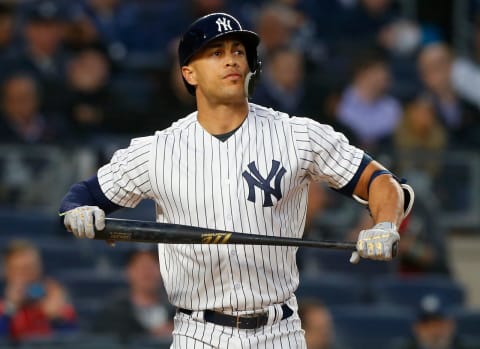
Giancarlo Stanton, OF – Yankees (.230/.313/.425, 5 HR)
A quick look at Giancarlo Stanton and his Fangraphs page might leave New York Yankees fans worried. His walk rate has dropped from 12.3% to 9.4% since last season. His strikeout rate is up to 33.6%, a career high and up 10% from 2017. Along with the contact and discipline issues, his ISO has dropped to .195, a 155 point drop from his career-high .350 from last season.
And that’s the key here. 2017 was likely a career year for the 28-year-old mammoth slugger. And that’s okay. Giancarlo Stanton has a long way to fall before he’s not a great player. His early season struggles are a combination of a few things, but there is no reason to think Giancarlo Stanton has fallen off the table.
A few tweaks might be in order for Giancarlo Stanton
While the former Marlin is not suffering from poor BABIP luck, he is doing some things that shouldn’t be too hard to correct, once he’s taken a breath and gotten used to the new super bright lights of Yankee Stadium. For one, he sees too many pitches. The 4.29 P/PA of Giancarlo Stanton is a career high. He’s also squaring the ball up less frequently with a Brls/PA of 8.6, just 54th in all of MLB. His 11.0 was 3rd in the majors last year.
These things are likely related. Giancarlo Stanton is being more patient, but not attacking his pitch and doing damage as a result. This suggests he’s tentative, which likely means he’s pressing. He’ll snap out of it eventually. He’s too good not to.
The hard hit percentage of Giancarlo Stanton is 52.1%, up 6.6 from 2017, and his expected slugging is .501. And his average launch angle is down 2.6 degrees from last season, 5.5 from 2016. These are all correctable things, and some may sort themselves out when Giancarlo Stanton gets over the enhanced pressure of playing in the Bronx.
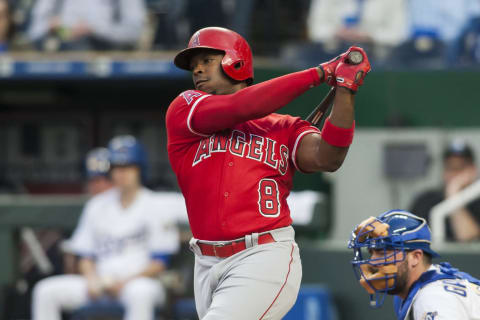
Justin Upton, OF – Angels (.229/.293/.376, 4 HR)
Justin Upton just isn’t hitting yet. Part of that is the nearly 70 point drop in BABIP, but he was due from some regression there anyway. Is he declining rapidly or just in a temporary funk? The answer is a bit complicated.
While he’s been a below average hitter for results, his expected stats are more encouraging. Baseball Savant has his xSLG at .469 and his xwOBA at .345. While both are lower than his 2017 figures, both are also massive improvements over his 2018 numbers.
He’s barreling balls at a similar rate to last season, and he has a similar rate of pulled, center and opposite field balls. The one big difference I can see is that his launch angle is down 3.4 degrees.
Spread it around.
One notable difference is that he’s pulling the ball at a 43.2% rate, the highest of his career. The entire difference from his 2017 rates is in his pull and opposite field numbers. His center percentage is nearly identical. If he can start going with pitches the other way again, that might get him going and move his stats a little closer to the near career year he had in 2017.
Another thing to keep an eye on is that pitchers are throwing to him down and away quite a bit. This could be expanding the zone allowing for called strikes to the inside. He’s swinging inside a lot more than chasing away, though, so it could be a matter of making an adjustment to how he’s being attacked.
It’s almost certain that he will fall off from last year, but Justin Upton can still put up a productive season, and that could go a long way toward keeping the Angels in the playoff hunt.
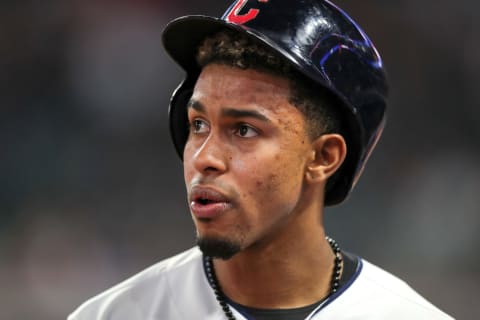
Francisco Lindor, SS – Indians (.245/.331/.409, 4 HR, 5 SB)
Finishing 5th in MVP voting last season, the sky was the limit for Francisco Lindor in 2018. After a month, he’s a league average hitter with a 7.7% jump in strikeout rate. Is the sky falling? Not really, no. The new-found swing and miss doesn’t appear to be due to any detectable changes in approach, and he’s too young to have a decline phase kicking in.
Francisco Lindor’s O-Swing% is up a touch, and his Z-Swing% is down a bit, but he’s making contact at virtually the same rate outside of the zone. It’s within the zone that he’s seen a drop, and that could very well be small sample size noise. His Z-Contact% last season was 93.0 as compared to the 85.3 he’s posted in 2018. His career season low is 89.7% so you can expect this year’s rate to climb going forward.
Something doesn’t add up.
When hitters expand the zone, the accompanying swinging strike rate bump is usually concerning. In this case, since Francisco Lindor isn’t swinging and missing more out of the zone, however, we know that the jump in strikeouts isn’t driven by that expansion of the zone. He’s not paying for reaching, though he could be seeing more pitches on the inner part of the plate that are busing him a bit as he leans following a chase.
Chances are he’ll start squaring up balls in the zone sooner rather than later. At that point, 2017 Francisco Lindor should start showing up at the ballpark again.
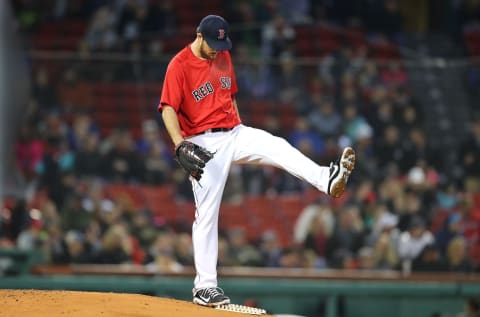
Might not
Drew Pomeranz, SP – Red Sox (7.27 ERA, 0 W, 1 L)
After two straight strong seasons, Drew Pomeranz is off to a terrible start. A 7.27 ERA, even with a 3.83 xFIP indicates something serious has gone wrong with the lefty. It could be mechanical, but the bigger worry is that his elbow is finally giving out. When the Red Sox acquired him in 2016, there was a massive controversy over the San Diego Padres withholding medical information.
The league allowed the Red Sox to void the trade if they wished, but Dave Dombrowski opted to keep Pomeranz, and the Padres were merely fined for the infraction. It looked like a right decision through the end of the 2017 season. This spring training, however, a forearm strain derailed the start of his 2018 campaign.
Forearm strains are often a sign of elbow trouble and can sometimes be precursors to UCL tears. Pain in the forearm alone isn’t enough to jump to that conclusion, however, so we need to look for more signs.
A big one is the 2.41 MPH drop in velocity from last season. His four-seam fastball velocity in 2017 was 91.79 MPH. His sinker averaged 90.37. This season those numbers are 89.37 and 87.57 respectively. Those are big drops. This is the lowest his velocity has been clocked at this early in a year at any point in his career.
It gets worse.
Additionally, he’s walking more batters than he has since he was with the Rockies in 2013. His strikeout stuff is still there, but when he gets hit he’s getting hit extremely hard. His hard hit percentage according to Fangraphs is nearly 20 points higher than it was in 2017.
In short, Pomeranz is hitting the zone less frequently, is throwing softer than he ever has before and he’s getting crushed when he does throw strikes. The curve is still effective, but without a workable fastball, that won’t matter. Either he’s hurt, or he’s in dire need of some time to work out significant mechanical errors. My money is on an injury. Don’t be surprised to see him hit the DL soon.
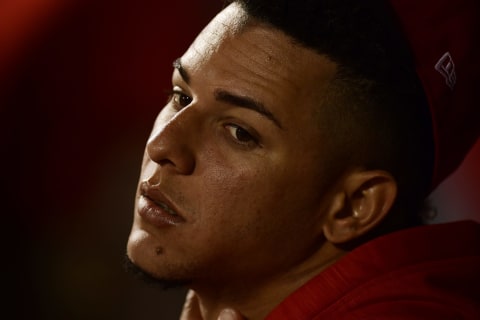
Luis Castillo, SP – Reds (7.85 ERA, 1 W, 3 L)
Luis Castillo has also suffered a velocity drop, though not quite as severe. His four-seamer has dropped from 97.87 MPH to 96.02, and his sinker has gone from 97.29 down to 95.62. He has altered his pitch usage from last year, perhaps because of that decline in velocity. His four-seam fastball usage has gone from his most used pitch at 39.5% to his third least behind the sinker and the changeup.
More from Call to the Pen
- Philadelphia Phillies, ready for a stretch run, bomb St. Louis Cardinals
- Philadelphia Phillies: The 4 players on the franchise’s Mount Rushmore
- Boston Red Sox fans should be upset over Mookie Betts’ comment
- Analyzing the Boston Red Sox trade for Dave Henderson and Spike Owen
- 2023 MLB postseason likely to have a strange look without Yankees, Red Sox, Cardinals
With less velocity, more movement might be preferable. And the change in velocity is slight enough that it could be a matter of him taking something off to spot his pitches better.
Unfortunately, it coincides with an increase in his walk rate from 8.9 to 9.9%, not a decrease as you might expect. His strikeout rate has dropped from 27.3%, which is elite for a starter, to 18.3%. So, like Pomeranz, he’s throwing softer (relatively speaking), with less accuracy, and with less effectiveness.
Don’t give up on him yet.
He’s giving up 4.4% more hard contact, but there are reasons to hope he can turn it around — while he didn’t need to ramp up his velocity in 2017, after his first full season workload (169.2 IP) that he was more fatigued over the winter than he ever has been before. He’s also sporting a swinging strike rate of 0.9% higher than last year.
So he’s generating swings and misses, he’s just not getting them at the end of plate appearances as often as last year. That could be only random noise. He’s also getting more swings outside of the zone than last year while seeing fewer while in the zone. That usually leads to good things.
It’s worth waiting and seeing with Luis Castillo, even if there are some scary signs. The chances of this being an early season blip on the radar are significantly higher than with Drew Pomeranz.
Next: Red Sox and city of Boston rename Yawkey Way
Will the likes of Giancarlo Stanton return to his MVP ways of a year ago? What about his fellow MLB counterparts? With warmer weather, we could see the bats heat up. Meanwhile on the mound, maybe a few adjustments will fix the mechanics ailing these list of strong arms.